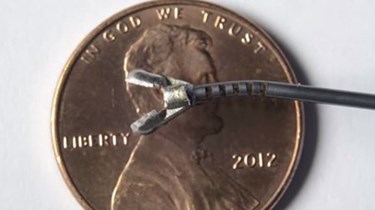Tiny Mechanical Wrists Could Expand Needlescopic Surgery Options

Vanderbilt scientists have added a new innovation to their existing steerable needle technology: a tiny flexible wrist. The technology will make it possible to perform even more delicate surgical procedures, such as suturing and tissue resection, using minimally invasive micro-laparoscopic techniques.
Fewer cuts and smaller incisions mean faster healing times, but miniature surgeries require miniature tools, and scaling down surgical equipment presents a specific set of challenges.
“The smaller you can make surgical instruments the better… as long as you can maintain an adequate degree of dexterity,” said S. Duke Herrell, a professor of urological surgery who consulted on the Vanderbilt project, in a press release.
In recent years, surgical robots have generated a lot of attention because of their ability to do micro-scale work through small incisions — without the added risk of human fatigue. Robert Webster, professor of mechanical engineering at Vanderbilt, mentioned that Intuitive Surgical’s da Vinci Surgical system was particularly good at abdominal surgery, which it can perform through incisions that are between 5 mm and 8 mm wide.
Still, Webster wondered if it wouldn’t be possible to go even smaller. “The da Vinci uses wire-and-pulley system that is extremely difficult to miniaturize any further, so it won’t work in smaller spaces like the head and neck,” he said.
For the last six years, Webster and his team have been developing a surgical system using tools the size of sewing needles that can be guided or “steered” by a surgeon through incisions. By precisely rotating and extending a system of tiny nitinol tubes, researchers have been able to perform a number of tasks such as biopsy and clot removal.
In a recent paper presented at the International Conference on Robotics and Automation, Webster’s team discussed its development of a “wrist” that could broaden the capabilities of robotic surgical needles. By cutting small notches into the nitinol tubes and threading them with wire, scientists enabled the needles to bend around corners in very tight spaces.
“Adding the wrists to the steerable needles greatly expands the system’s usefulness,” said Herrell. “There are a myriad of potential applications in some really exciting areas such as endoscopic neurosurgery, operating within small lumens such as the ear, bronchus, urethra, etc. This would allow us to do surgeries that at present require much larger incisions and may even enable us to perform operations that are not feasible at present.”
Vanderbilt applied for a provisional patent in May and the research team plans to continue perfecting the design throughout the summer. By the end of this summer, they intend to complete the software necessary to operate the system. If the researchers find the right commercial partner, Webster says the surgical system could be available in five years.
